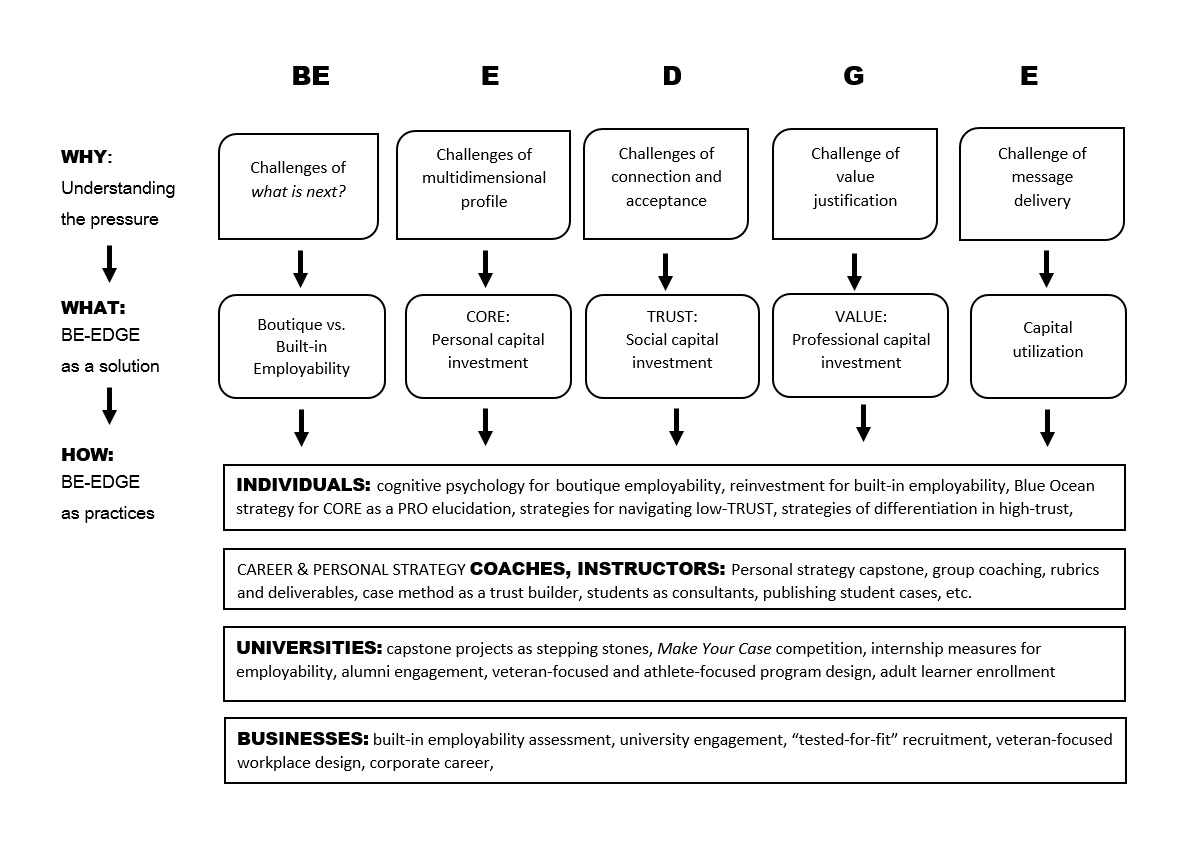
The Map of This Blog
By Julia Ivy
November 26, 2019
When I started to write my blog, I followed a desire to share my thoughts behind BE-EDGE and how it can be applied for individuals, universities, coaches, and businesses. Besides, my friends kept pushing me to do so. But then, I challenged myself whether the use and logic of my posts are clear, so you as a reader can easily find helpful information.
So, I developed a map, where each post can be located. Then, when my former students started to share their insights on how BE-EDGE worked for them, I shared this platform with them. At the end of the day, this is about thoughts exchange and learning from each other.
The map looks like a matrix or a flow chart, where one dimension covers the BE-EDGE steps: BE (Boutique/Built-in Employability) as a goal and a result, which can be achieved through the E-D-G-E (Elucidate CORE-Develop TRUST -Generate VALUE-Excite MARKET) steps.
Another dimension includes three levels of making BE-EDGE work: the WHY, the WHAT, and the HOW. This dimension helps me communicate the meaning and hopefully the contribution that my posts can make for one’s dealing with the what’s next? journey — as a person who faces this challenge, or a professional who works with people that face this challenge. I will use this dimension as the central for my map.

The First Level is WHY: Understanding What’s Next? Pressure
The posts here relate to the webpage “BE-EDGE for Individuals,” and these individuals are:
- (a) graduates, most of whom currently are Millennials
- (b) highly accomplished professionals, which includes veterans, former athletes, retirees, and those accomplished professionals who are ready for the what’s next? journey
If you are, or you assist, one of the groups of clients (say, you are a career coach for Millennials or a service provider for veterans in their transition to civilian life), you can follow the BE-EDGE steps for your specific group and discuss rationale and mechanisms that drive (or restrain) you or your client at “What next?” stage in life.
Specifically, I will discuss the nature of the BE or employability-related pressure, and how that pressure might be different for graduating or recently graduated Millennials and for highly accomplished professionals. My post “Three types of what’s next? challenges” should be located here.
I will also share data and thoughts on the EDGE — psychological, social, professional, and communicational career profile of these individuals. E.g., ‘Millennials are multidimensional!” are about the psychological profile of graduates, while “Why don’t we trust Millennials?” is about their social part of their profile. I will keep writing these posts to share personal, social, professional, and communicational profiles of each of these groups.
The Second Level is WHAT: Understanding BE-EDGE
Here I refer to the “About BE-EDGE” page of my website but actually explain in detail what each of the BE-EDGE components means from the personal strategy point of view. Following the BE-EDGE steps, I focus on them as investments into one’s employability:
- Personal capital (Elucidating a CORE),
- Social capital (Developing TRUST),
- Professional capital (Generating VALUE),
- Capital utilization (Exciting MARKET), and
- Resulting BE (Boutique/Built-in Employability)
Because I have the liberty of writing longer posts, where I can provide real-life examples and their conceptual explanation through psychology and strategy. The “Psychology of what’s next? choices, “Social capital in a low-trust environment,” “Social capital for differentiation in a high-trust environment,” “Design thinking of “Me” professional project,” or “Market-based vs. Boutique vs. Built-in Employability” are examples of posts at this level.
The Third Level is HOW: Practicing BE-EDGE
We work for different institutions — universities, nonprofit or government organizations, businesses, or own coaching practices. It means that we might have different ways to apply BE-EDGE, so these ways will be discussed in this section.
- For individuals who decide to take ownership of crafting their boutique employability, I will share tips on how to outreach a desirable employer and engage her into BE-EDGE, what platforms you can use for your projects, and how you can capitalize on the projects you do anyway.
- For universities, I will write posts on career design-focused internships, capstone courses, or Make Your Case competitions, alumni services, corporate leadership programs, or initiatives for adult learner enrollment.
- For businesses and nonprofit or government organizations, these would be posts on an assessment and reconfiguration for veterans’ or athletes’ built-in employability, “tested-for-fit” talent recruitment, veteran-focused workplace design, corporate leadership programs, university engagement for “tested-for-fit” graduates’ recruitment, and more.
- For coaches and instructors who include BE-EDGE to their practices, I will share my experience in coaching and consulting within my work as a professor or within my private practice. The posts might cover ideas and practices of “Group coaching sessions on mindfulness for what’s next? choices,” “Course design and deliverables of student-centered capstones,” “Case method as a trust builder,” “Dynamic of student case teams,” “Publishing student cases for their visibility,” and any other practical posts.
It’s Time for BE-EDGE Journey
I guess, now when my map is ready, I have no excuse to avoid writing my blog. I hope this map will help you to locate the post that you need, or to understand how the post you like relates to a larger picture. At least, it has already helped me to make sense of what I am writing about!

